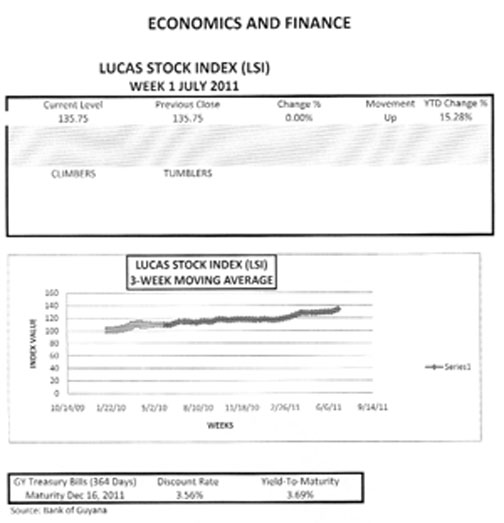Attractive Prices
At the time of writing this article, the price of gold had jumped by US$17 to reach US$1,531 from its closing price of Tuesday. The price of this precious metal seems to be in a zone of its own and is leading experts to believe that it could hit US$1,600, or even US$2,000, before the year is out. Such a trend is good news to a country like Guyana that is blessed with abundant gold and other natural resources. But it is gold that is stealing the show. According to the Bank of Guyana (BOG), while other major exports did not fare so well, gold production was up 21 percent in the first quarter of the year. With market prices heading for the stratosphere, the BOG expects gold production to continue growing during the course of the year as miners seek to capitalize on the attractive prices. Unless something dramatic happens, export revenues from gold should expand by about 20 percent and give the Guyana economy a shot in the arm.
No Consistency
Like last year, the expected benefits to the Guyana economy derive more from good fortune than from strategic policy action on the part of the administration. There is no consistency in the direction of manufacturing output and agriculture continues to play its favourite game of hide-and-seek with Guyanese consumers. Describing the first quarter performance as “subdued economic growth”, the BOG could point to no specific policy prescription that has kept the Guyana economy going forward. Where problems exist, a third force always seems to be at fault. This time around, it is La Nina, one of the children of atmospheric descent and of the global warming generation.
Surprised

From the report of the BOG, the administration appeared surprised by the performance of the Guyana economy. Guyanese policymakers had tied a strong performance of the domestic economy to the global recovery and higher prices for exports. While the global recovery has occurred and the export revenue index for major exports moved up more than three percent, production in many important industries contradicted the forecast. Despite high spending on information technology and hydrometeorological services, economic models are clearly not taking sufficient account of the impact of rainfall on agriculture and forestry. Nor does it look as if policymakers expected the high variability in export prices of these products.
Consequently, many products in the forestry industry declined by hefty margins, and revenues, which did not match expectations, fell by 17 percent. Fisheries production fell by 11 percent and bauxite went down nine percent. This is not good news in an election year for the administration and it appears that it is relying on gold prices to bring it some help. It is not surprising therefore that the gold industry has emerged as the preferred whipping boy of the administration this time around.
Blessing in Disguise
The driver of the favourable market price of gold remains the unsteady and uneasy conditions of the global economy. The turmoil in the global economy is not always a friend of developing countries. Yet, the lingering crisis comes as a blessing in disguise for Guyana. With a very narrow export market focus, under normal circumstances, Guyana would find it difficult to manage the impact that an upheaval in the economies of major trading partners brings. Making matters worse is the absence of the special preferential treatment for sugar and rice that once protected these commodities from the vagaries of the commodity marketplace. Despite the coincidence, this year has already seen a decline in rice, for example, to the European markets. The export fortune of rice has also taken a turn for the worse in the Caribbean. Yet, events like the sovereign debt-crisis in Europe and the discord in Guyana’s major North American market are generating unexpected benefits for Guyana. Sugar, for example, will enjoy greater access to the US market this year, if it can make production targets. But the larger effect is coming from gold. The unfortunate economic events in Europe and North America have helped to push up the demand for gold and its price as a result.
Delicacy
In a Personal Finance column of Forbes online magazine written on June 23, 2011, the author identifies fears about inflation as a principal cause of the rush to gold. Gold has also become a safety valve for many countries seeking to reduce their dependency on the US dollar as a reserve currency. It should come as no surprise to anyone that China is at the top of the list of the current gold buyers. China has developed a reputation for gobbling up the primary commodities of other countries and right now gold is a delicacy of the import menu. But it seems more concerned about balancing out its foreign exchange reserves and, like major European countries, has turned to gold, instead of the weaker US dollar, to do so.
Start of the Hunt
Only one year ago, gold made up less than one percent of China’s foreign exchange reserves, now it is already at 2 percent and since no one knows what the Chinese target is, expectations about gold demand remain high. A December 2010 report in the online version of the Wall Street Journal noted that China increased its purchase of gold five-fold from import levels of 2009, and that might have only been the start of the hunt. Even though China is self-sufficient in gold production, Forbes reports in its June 23 online issue that import demand by China is projected to rise by as much as 15 percent this year on continued fears of inflation.
Illogical Path
Despite the high prices, both the production and export of gold in Guyana seem to follow an illogical path. Data published by the Guyana Bureau of Statistics indicate that, despite the steady rise in price, the rate of increase in gold production and exports have not remained on an upward trajectory. Even the Guyana Gold and Diamond Miners Association (GGDMA) seems to be having trouble figuring out its optimal position. While the GGDMA projected output of 500,000 ounces last year, official statistics put output at under 400,000.
It is not clear what slowed output last year, but the industry obviously has much to worry about. Conflict between the GGDMA and the administration has surfaced over production levels and neither side seems convinced of the other’s point of view. However, with world prices where they are, those differences might just be set aside by the administration in its search for a good election narrative.








